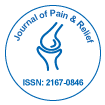Hypnoanalgesic Autonomous Patient: Nasogastric Tube Insertion after Receiving High Dose Chemotherapy
Received: 10-May-2023 / Manuscript No. JPAR-23-98338 / Editor assigned: 12-May-2023 / PreQC No. JPAR-23-98338 (PQ) / Reviewed: 26-May-2023 / QC No. JPAR-23-98338 / Revised: 02-Jun-2023 / Manuscript No. JPAR-23-98338 (R) / Accepted Date: 13-May-2023 / Published Date: 09-Jun-2022 DOI: 10.4172/2476-2024.8.S1.001
Description
Hypnoanalgesia, defined as a non-pharmacological sedation process, is developing more and more in medical practice, especially to accompany invasive and painful procedures such as implanted ports, catheter insertions, bone marrow biopsies and lumbar puncture [1]. Patients undergoing high dose chemotherapy experienced tissue aggression affecting oropharyngeal and gut tissue. Mucositis and enterocolitis represent important complications for patients with persistent aplasia, predisposing them to malabsorption and malnutrition. The issue of caloric intake in these patients is therefore crucial [2]. The insertion of a Naso Gastric (NG) tube is considered as a difficult and aggressive experience by both patients and caregivers, but represents an interesting alternative for feeding patients as compared to parenteral support. We recently reported our experience including 38 patients suffering from hematological malignancies and receiving high dose chemotherapy in the context of acute leukemia or stem cell transplantation [3]. All of them were accompanied by a hypno-practitioner nurse during NG tube insertion. This was performed based on conventional procedures and preceded by local anaesthesia in the nostril. The NG tube was lubricated and given to the patient himself for autonomous nasal self-insertion. The patient voluntarily took hold of the NG tube in a cataleptic process. The nurse explained the procedure using metaphors helping the patient to mentally map their gastrointestinal tract. The patient set the pace and was completely focused on the hand performing the procedure and the professional mirrored the patient’s gestures. The hypnotherapist then changed the rhythm by interspersing periods of silence with periods of logorrhea. She described the mental map, while the patient effortlessly inserted the NG tube. All the patients experienced successful NG tube self-insertion. The NG tube remained in place during hospitalization in 32 cases for an average duration of 15 days. Interestingly, six patients who rejected the tube, were able to reinsert it autonomously without any physical intervention of the hypnotherapy nurse. By contrast, we previously observed that around half of patients of our department refused NG tube reinsertion after rejection, when it had been inserted using traditional procedures. Indeed, by inserting the NG tube themselves, patients are fully involved in the procedure and play an active role. This experience could no longer be remembered as difficult and the patient can thus repeat the gesture easily during subsequent hospitalizations.
In conclusion, this pilot study suggests that NG tube self-insertion assisted by hypnoanalgesia may be effective, well-accepted and welltolerated in patients with HD chemotherapy-induced aplasia. We have now deleted local anesthesia from our procedure to prevent irritation of the nasal and pharyngeal mucosa. Between 2018 and 2023, we have offered this technique to more than 400 patients and are convinced of the validity of this procedure. It represents a robust alternative to traditional NG tube insertion and is considered as non-traumatic procedure. These promising results have encouraged us to lunch a prospective and randomized study comparing NG tube placement with or without hypnosis including 180 patients which will start in June 2023. The field of hypnosis should expand in the near future. We are extending our hypnosis program to bone marrow biopsies and support for caregivers in a palliative care situation.
References
- Carlson LE, Toivonen K, Flynn M, Deleemans J, Piedalue KA, et al. (2018) The role of hypnosis in cancer care. Curr Oncol Rep 20:90-93.
[Crossref] [Google Scholar] [PubMed]
- Vries EG, Mulder NH, Houwen B, Vries-Hospers H G (1982) ). Enteral nutrition by nasogastric tube in adult patients treated with intensive chemotherapy for acute leukemia. Am J Clin Nutr 35: 1490-1496.
[Crossref] [Google Scholar] [PubMed]
- Granger M, Anthony N, Lermenier C, Hue D, Mear JB, et al. (2023) Patients Participating in Nasogastric Tube Insertion through Hypnoanalgesia during High-dose Chemotherapy-induced Aplasia. Int J Clin Exp Hypn 71: 79-88.
[Crossref] [Google Scholar] [PubMed]
- Horiuchi Y, Hayashi F, Iwasaki Y, Matsuzaki A, Nishibe K, et al. (2021) Peripheral granular lymphocytopenia and dysmorphic leukocytosis as simple prognostic markers in COVID-19. Int J Lab Hematol 43:1309-1318.
[Crossref] [Google Scholar] [PubMed]
Citation: Granger M, Lamy T (2023) Hypnoanalgesic Autonomous Patient: Nasogastric Tube Insertion after Receiving High Dose Chemotherapy. J Pain Relief Open S1: 001. DOI: 10.4172/2476-2024.8.S1.001
Copyright: © 2023 Granger M, et al. This is an open-access article distributed under the terms of the Creative Commons Attribution License, which permits unrestricted use, distribution, and reproduction in any medium, provided the original author and source are credited.
Share This Article
Recommended Conferences
42nd Global Conference on Nursing Care & Patient Safety
Toronto, CanadaRecommended Journals
Open Access Journals
Article Tools
Article Usage
- Total views: 825
- [From(publication date): 0-2023 - Apr 06, 2025]
- Breakdown by view type
- HTML page views: 590
- PDF downloads: 235
